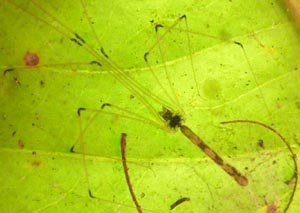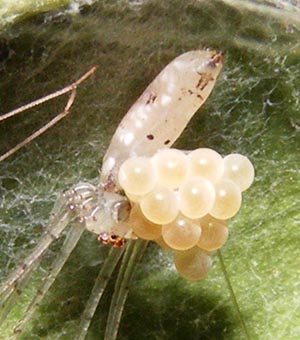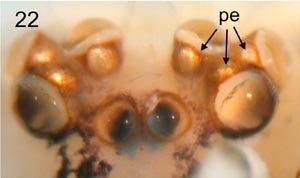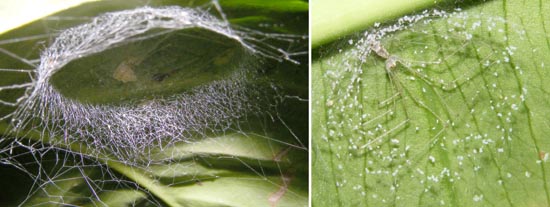
Many
tropical pholcid spider species are
morphologically and behaviourally adapted to life on the underside of
green
leaves. The taxonomy of these cryptic spiders is partly poorly known,
and
almost nothing is known about their biology. Leptopholcus guineensis, shown on
the right, was previously known from only two female specimens: the
types collected in 1937.
During a trip to Guinea in 2008, we collected a total of seven leaf-dwelling species representing six genera, with up to five species per locality (Forêt Classée de Diéké). Shown below are: Crossopriza (now Smeringopus) cylindrogaster (a), Nyikoa limbe (b), Leptopholcus tipula (c), Spermophora dieke (d), Pehrforsskalia conopyga (e), and Pholcus kakum (f). At the level of genera, this is comparable to the diversity of leaf-dwelling pholcids reported by Deeleman-Reinhold (1986) for Indonesia (seven genera).

 Most
remarkable is Crossopriza
cylindrogaster, a species
described by Eugene Simon over 100 years ago based on a single female
specimen
and never mentioned again in the scientific literature. It has an
inverted
resting position (dorsal side pressed against the leaf; see on the
left),
tetrahedral egg-sacs, modifications of
the
lateral eyes that appear like additional lenses ("pe" in the figure
shown here), and lampshade webs
with or without
‘ornaments’ (puffs of silk) (below).
Most
remarkable is Crossopriza
cylindrogaster, a species
described by Eugene Simon over 100 years ago based on a single female
specimen
and never mentioned again in the scientific literature. It has an
inverted
resting position (dorsal side pressed against the leaf; see on the
left),
tetrahedral egg-sacs, modifications of
the
lateral eyes that appear like additional lenses ("pe" in the figure
shown here), and lampshade webs
with or without
‘ornaments’ (puffs of silk) (below).

 PDF
PDF